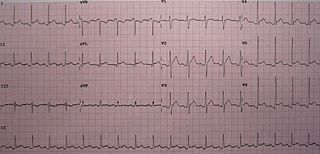Related Research Articles

A mood stabilizer is a psychiatric medication used to treat mood disorders characterized by intense and sustained mood shifts, such as bipolar disorder and the bipolar type of schizoaffective disorder.
In medicine, a side effect is an effect, whether therapeutic or adverse, that is unintended; although the term is predominantly employed to describe adverse effects, it can also apply to beneficial, but unintended, consequences of the use of a drug.

Propranolol, sold under the brand name Inderal among others, is a medication of the beta blocker class. It is used to treat high blood pressure, a number of types of irregular heart rate, thyrotoxicosis, capillary hemangiomas, performance anxiety, and essential tremors, as well to prevent migraine headaches, and to prevent further heart problems in those with angina or previous heart attacks. It can be taken orally or by intravenous injection. The formulation that is taken orally comes in short-acting and long-acting versions. Propranolol appears in the blood after 30 minutes and has a maximum effect between 60 and 90 minutes when taken orally.

Colchicine is a medication used to prevent and treat gout, to treat familial Mediterranean fever and Behçet's disease, and to reduce the risk of myocardial infarction. The American College of Rheumatology recommends colchicine, nonsteroidal anti-inflammatory drugs (NSAIDs) or steroids in the treatment of gout. Other uses for colchicine include the management of pericarditis.

Bupropion, formerly called amfebutamone, and sold under the brand name Wellbutrin among others, is an atypical antidepressant primarily used to treat major depressive disorder and to support smoking cessation. It is also popular as an add-on medication in the cases of "incomplete response" to the first-line selective serotonin reuptake inhibitor (SSRI) antidepressant. Bupropion has several features that distinguish it from other antidepressants: it does not usually cause sexual dysfunction, it is not associated with weight gain and sleepiness, and it is more effective than SSRIs at improving symptoms of hypersomnia and fatigue. Bupropion, particularly the immediate release formulation, carries a higher risk of seizure than many other antidepressants, hence caution is recommended in patients with a history of seizure disorder.

Pericarditis is inflammation of the pericardium, the fibrous sac surrounding the heart. Symptoms typically include sudden onset of sharp chest pain, which may also be felt in the shoulders, neck, or back. The pain is typically less severe when sitting up and more severe when lying down or breathing deeply. Other symptoms of pericarditis can include fever, weakness, palpitations, and shortness of breath. The onset of symptoms can occasionally be gradual rather than sudden.

Opioid use disorder (OUD) is a substance use disorder characterized by cravings for opioids, continued use despite physical and/or psychological deterioration, increased tolerance with use, and withdrawal symptoms after discontinuing opioids. Opioid withdrawal symptoms include nausea, muscle aches, diarrhea, trouble sleeping, agitation, and a low mood. Addiction and dependence are important components of opioid use disorder.

Buprenorphine, sold under the brand name Subutex among others, is an opioid used to treat opioid use disorder, acute pain, and chronic pain. It can be used under the tongue (sublingual), in the cheek (buccal), by injection, as a skin patch (transdermal), or as an implant. For opioid use disorder, the patient must have moderate opioid withdrawal symptoms before buprenorphine can be administered under direct observation of a health-care provider.

Naltrexone, sold under the brand name Revia among others, is a medication primarily used to manage alcohol use or opioid use disorder by reducing cravings and feelings of euphoria associated with substance use disorder. It has also been found effective in the treatment of other addictions and may be used for them off-label. An opioid-dependent person should not receive naltrexone before detoxification. It is taken by mouth or by injection into a muscle. Effects begin within 30 minutes, though a decreased desire for opioids may take a few weeks to occur. Side effects may include trouble sleeping, anxiety, nausea, and headaches. In those still on opioids, opioid withdrawal may occur. Use is not recommended in people with liver failure. It is unclear if use is safe during pregnancy. Naltrexone is an opioid antagonist and works by blocking the effects of opioids, including both opioid drugs as well as opioids naturally produced in the brain.

Indometacin, also known as indomethacin, is a nonsteroidal anti-inflammatory drug (NSAID) commonly used as a prescription medication to reduce fever, pain, stiffness, and swelling from inflammation. It works by inhibiting the production of prostaglandins, endogenous signaling molecules known to cause these symptoms. It does this by inhibiting cyclooxygenase, an enzyme that catalyzes the production of prostaglandins.

An opioid antagonist, or opioid receptor antagonist, is a receptor antagonist that acts on one or more of the opioid receptors.

Lofexidine, sold under the brand name Lucemyra among others, is a medication historically used to treat high blood pressure; today, it is more commonly used to help with the physical symptoms of opioid withdrawal. It is taken by mouth. It is an α2A adrenergic receptor agonist. It was approved for use by the Food and Drug Administration in the United States in 2018.

Lurasidone, sold under the brand name Latuda among others, is an antipsychotic medication used to treat schizophrenia and bipolar disorder. It is taken by mouth.

An opioid overdose is toxicity due to excessive consumption of opioids, such as morphine, codeine, heroin, fentanyl, tramadol, and methadone. This preventable pathology can be fatal if it leads to respiratory depression, a lethal condition that can cause hypoxia from slow and shallow breathing. Other symptoms include small pupils and unconsciousness; however, its onset can depend on the method of ingestion, the dosage and individual risk factors. Although there were over 110,000 deaths in 2017 due to opioids, individuals who survived also faced adverse complications, including permanent brain damage.

Naltrexone/bupropion, sold under the brand name Contrave among others, is a fixed-dose combination medication for the management of chronic obesity in adults in combination with a reduced-calorie diet and increased physical activity. It contains naltrexone, an opioid antagonist, and bupropion, an aminoketone atypical antidepressant. It is taken by mouth. Both medications have individually shown some evidence of effectiveness in weight loss, and the combination has been shown to have some synergistic effects on weight.

Samidorphan is an opioid antagonist that in the form of olanzapine/samidorphan is used in the treatment of schizophrenia and bipolar disorder. Samidorphan reduces the weight gain associated with olanzapine. Samidorphan is taken by mouth.

Buprenorphine/naloxone, sold under the brand name Suboxone among others, is a fixed-dose combination medication that includes buprenorphine and naloxone. It is used to treat opioid use disorder, and reduces the mortality of opioid use disorder by 50%. It relieves cravings to use and withdrawal symptoms. Buprenorphine/naloxone is available for use in two different forms, under the tongue or in the cheek.
Buprenorphine/naltrexone is an experimental combination drug formulation of buprenorphine, a μ-opioid receptor (MOR) weak partial agonist and κ-opioid receptor (KOR) antagonist, and naltrexone, a MOR and KOR silent antagonist, which is under investigation for the potential treatment of psychiatric disorders. The combination of the two drugs is thought to result in a selective blockade of the KOR and hence fewer MOR activation-related concerns such as euphoria and opioid dependence. It has been found to produce antidepressant-like effects in mice and has recently been found to be effective in the treatment of cocaine dependence in a large clinical trial.
Kelly J. Clark is an American physician and psychiatrist known for her work in the fields of substance use disorder, addiction medicine, and addiction psychiatry.
References
- ↑ Paduda, Joe (2007-05-04). "UPDATE - The lollypop story gets big - Managed Care Matters". Joe Paduda. Archived from the original on 2011-11-19. Retrieved 2011-11-21.
- ↑ Boseley, Sarah (2006-06-17). "Drugs firm blocks cheap blindness cure". The Guardian. London. Retrieved 2010-05-20.
- ↑ "The Buprenorphine Effect on Depression" (PDF). Naabt.org. Retrieved 2013-04-30.
- ↑ Bodkin JA, et al. (1995). "Buprenorphine Treatment of Refractory Depression". Journal of Clinical Psychopharmacology. 15 (1): 49–57. doi:10.1097/00004714-199502000-00008. PMID 7714228.
- ↑ Maneeton, Narong; Maneeton, Benchalak; Srisurapanont, Manit; Martin, Stephen D. (2011-12-01). "Bupropion for adults with attention-deficit hyperactivity disorder: meta-analysis of randomized, placebo-controlled trials". Psychiatry and Clinical Neurosciences. 65 (7): 611–617. doi:10.1111/j.1440-1819.2011.02264.x. ISSN 1440-1819. PMID 22176279. S2CID 205476837.
- ↑ "Mood Stabilizers for Bipolar Disorder (Manic Depressive)". Leeheymd.com. 2003-08-01. Retrieved 2011-11-21.
- 1 2 Wing DA, Powers B, Hickok D (April 2010). "U.S. Food and Drug Administration Drug Approval: Slow Advances in Obstetric Care in the United States". Obstetrics & Gynecology . 115 (4): 825–33. doi:10.1097/AOG.0b013e3181d53843. PMID 20308845.
- ↑ "PsychiatryOnline | American Journal of Psychiatry | Doxepin as a potent H2 and H2 antihistamine for epigastric distress". Ajp.psychiatryonline.org. Retrieved 2011-11-21.
- ↑ "Archived copy" (PDF). Archived from the original (PDF) on 2007-08-09. Retrieved 2008-06-06.
{{cite web}}: CS1 maint: archived copy as title (link) - ↑ Shorter, Edward (2009). "The history of lithium therapy". Bipolar Disorders. 11 (Suppl 2): 4–9. doi:10.1111/j.1399-5618.2009.00706.x. PMC 3712976 . PMID 19538681.
- ↑ "Lithium Salts". The American Society of Health-System Pharmacists. Archived from the original on 8 December 2015. Retrieved 1 December 2015.
- ↑ Archived October 7, 2008, at the Wayback Machine
- ↑ Gold, Marji; Chong, Erica (September 2015). "If we can do it for misoprostol, why not for mifepristone? The case for taking mifepristone out of the office in medical abortion". Contraception. 92 (3): 194–196. doi:10.1016/j.contraception.2015.06.011. PMID 26093187 . Retrieved 31 October 2015.
- ↑ "Medscape: Medscape Access". Emedicine.com. Retrieved 2011-11-21.
- ↑ Salem EA, Wilson SK, Bissada NK, Delk JR, Hellstrom WJ, Cleves MA (2008). "Tramadol HCL has Promise in On-Demand Use to Treat Premature Ejaculation". The Journal of Sexual Medicine . 5 (1): 188–193. doi:10.1111/j.1743-6109.2006.00424.x. PMID 17362279. S2CID 31040664.